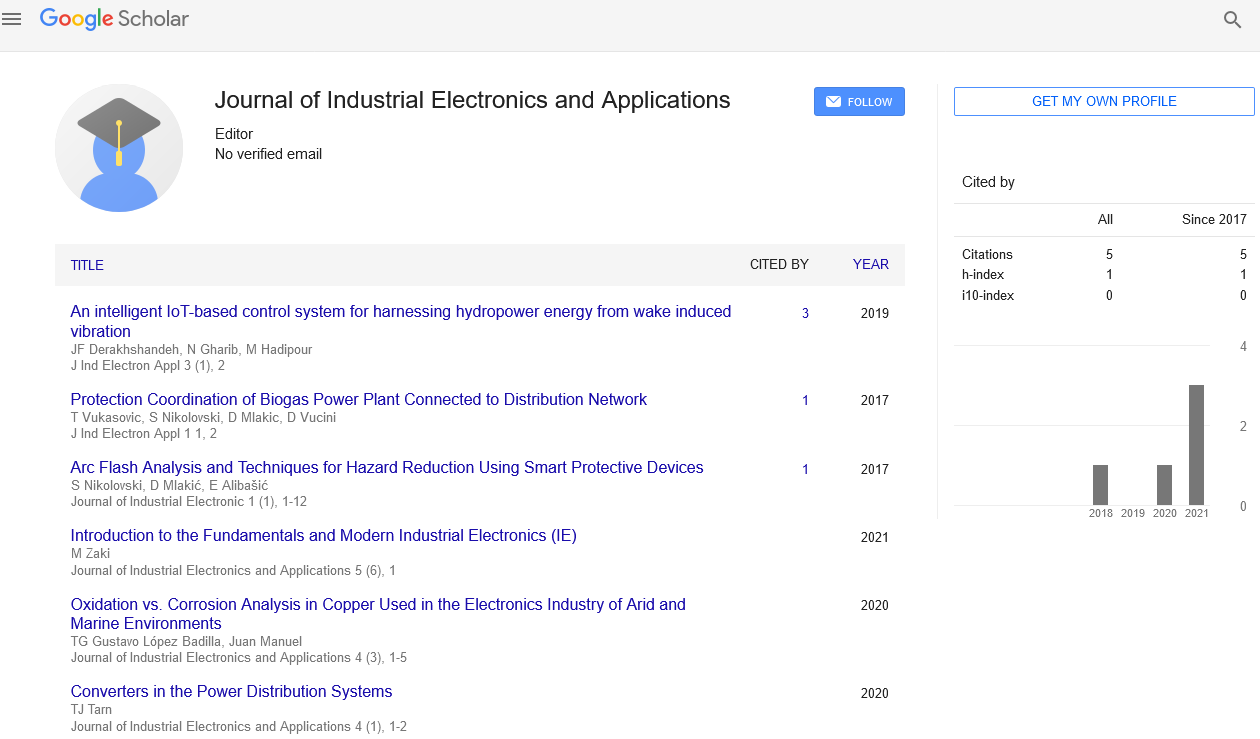Commentary, J Ind Electron Appl Vol: 6 Issue: 3
Industrial Waste Recycling To Develop Low Dielectric Constant
Helen Roy*
Department of Biomedical Engineering, Brno University of Technology, Technicka, Czech Republic
*Corresponding Author: Helen Roy, Department of Biomedical Engineering, Brno University of Technology, Technicka, Czech Republic
E-mail: hroy123@gmail.com
Received date: 11 April, 2022; Manuscript No. JIEA-22-77874;
Editor assigned date: 13 April, 2022; PreQC No. JIEA-22-77874 (PQ);
Reviewed date: 25 April, 2022; QC No. JIEA-22-77874;
Revised date: 05 May, 2022; Manuscript No. JIEA-22-77874 (R);
Published date: 13 May, 2022; DOI: 10.4172/Jiea.1000014
Citation: Grothey H (2022) Trends in Industrial Scale Synthesis of Quantum Dots and Application. J Ind Electron Appl 6:3.
Keywords: Power Electronics
Description
The premise of disease and can happen in more than one way. Transformations are changes in the DNA grouping that are gained during the existence of the phone, albeit in like manner use, they are considered acquired illness causing successions. Be that as it may, transformations can happen in substantial cells or be acquired in germ line cells. Transformations are all the more precisely and extensively characterized as any DNA change that increments risk for an infection or straightforwardly advances sickness development. DNA adjustments can go from single base-pair changes to whole chromosome gains or misfortunes, and any size change in the middle. There doesn't appear to be any limitation to the DNA arrangement changes that can happen during the advancement of disease. Notwithstanding DNA arrangement transforms, it likewise creates the impression that epigenetic changes can add to growth movement by adjusting quality articulation without modifying nucleotide sequence. Point transformations are single base-pair changes. In the coding districts of qualities, a point transformation that modifies the threeletter hereditary code so that the amino corrosive is changed is alluded to as a non-synonymous change. An interchangeable (quiet) change is one that doesn't adjust the amino corrosive at that position. Regularly, these quiet changes are believed to be nonfunctional, yet there might be covered up administrative groupings inside the coding locale that can cause a practical change. A point transformation may likewise change an amino corrosive to a stop codon, and alongside different transformations that prompt early end, it is frequently alluded to as a shortening transformation. Point transformations and different changes can likewise adjust quality administrative areas in the quality or at controller locales far off from the quality. Other normal little changes can modify quality joining, adjust record levels, or structure new proteins.
Inclusion and cancellations of at least one base can have similar impact as point changes. New amino acids can be added or erased to a protein, either enacting another capacity or erasing the ordinary capacity. Assuming the two duplicates of a quality are erased, it is known as a homozygous cancellation. Homozygous erasures are once in a while seen in a disease genome and are oftentimes a sign to the analyst that a cancer silencer quality was situated in the lost area of the genome. All the more as often as possible, just one duplicate of a quality is erased completely, and this happens in locales of Loss of Heterozygosis (LOH). LOH is regularly the principal hit in inactivating a growth silencer in irregular diseases, with the second inactivating more modest change happening in a cancer silencer quality inside the locale of LOH.
Solid Techniques
At the point when the quantity of alleles is expanded significantly past the typical two duplicates, it is known as genomic enhancement or quality intensification. Expanded duplicate quantities of a quality by genomic intensification are a solid sign that an oncogene is situated in the enhanced area. Qualities like mouse twofold moment 2 homolog (MDM2) and Epidermal Development Factor Receptor (EDFR), for instance are habitually intensified in GBMs. Either the ordinary quality can be viewed as enhanced (and essentially expands its not unexpected capacity to pathologic levels), or a transformed oncogene can be found in the intensified locale. Assuming that a typical quality succession is genomically intensified, it is as yet viewed as an oncogene assuming it brings about expanded articulation of the quality's protein and the expanded levels advance cancer development. Transformed qualities can likewise be available in genomically intensified districts, and the transformation could happen either previously or after the enhancement. DNA fingerprinting (additionally called DNA profiling or measurable hereditary qualities) is a method utilized by legal researchers to aid the ID of people or tests by their particular DNA profiles. Albeit over 99.1% of the genome is something very similar all through the human populace, the excess 0.9% of human DNA shows varieties between people. These variable DNA successions, named polymorphic markers, can be utilized to both separate and relate people. Alec, a geneticist at the University of Leicester in Britain, imagined the main usable rendition of DNA fingerprinting in 1984. Scarcely any years after the fact, a synthetic organization, Imperial Chemical Industries (ICI), sent off the main unit financially accessible. Despite the fact that it is a moderately new discipline, it enormously affected the law enforcement framework and society in everywhere. The use of legal hereditary qualities to the lawful field is intended to determine legitimate issues, for example, paternity tests and legacy matters, to lay out personality in criminal situations where natural proof is found at crime locations, and to distinguish survivors of mass catastrophes and missing people from human remaining parts. Although serologic and cell composing of HLA antigens have been incredibly valuable, there are various specialized downsides to these procedures. With the appearance of fast and solid techniques for the seclusion and portrayal of class I and class II qualities and the assurance of nucleotide arrangements of class I and class II alleles, it has become conceivable to utilize DNA-based strategies for HLA composing.
 Spanish
Spanish  Chinese
Chinese  Russian
Russian  German
German  French
French  Japanese
Japanese  Portuguese
Portuguese  Hindi
Hindi 